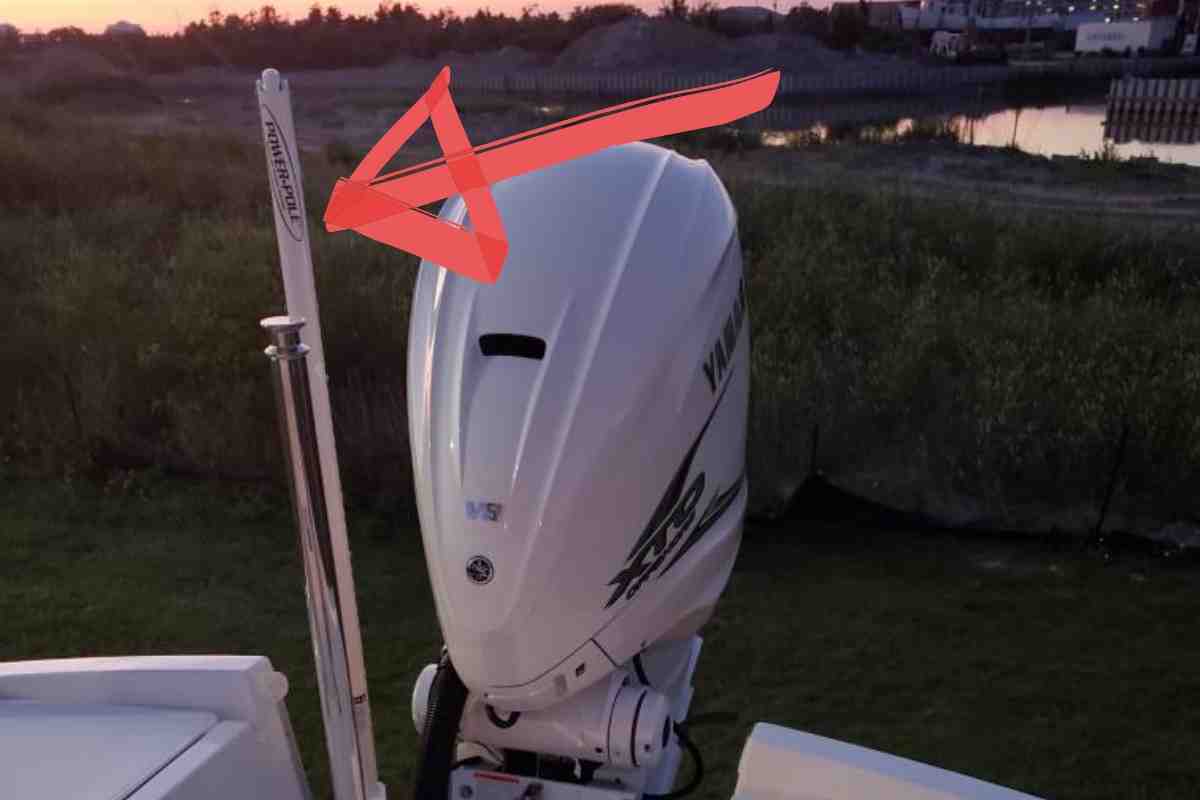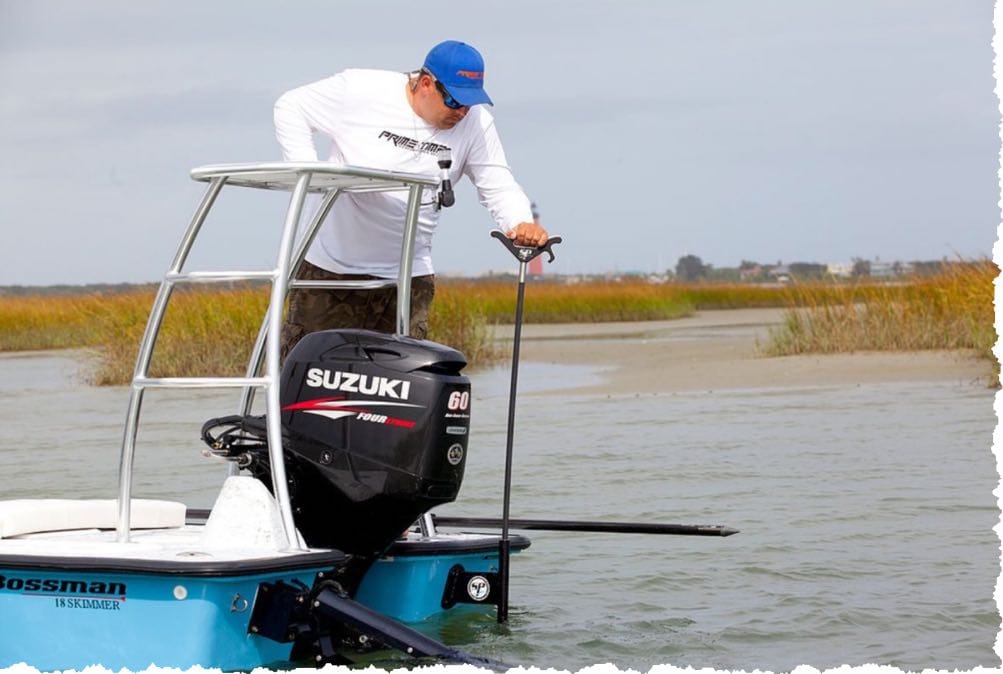3 Shallow Water Anchor Options: Power Pole vs. Stayput vs. DIY
For close, inshore fishermen, there is a need to have a quiet, steady boat to catch the biggest haul. A rocking boat can create unnecessary noise that can scare away any fish near you, leaving you empty-handed in an otherwise great spot.

Table of Contents
- What are the best options for shallow water anchors?
- Why Use a Shallow Water Anchor?
- What Is a Power Pole On a Boat?
- How Much Does a Power Pole Cost?
- Is a Power Pole Worth the Price?
- How Much Is It To Install A Power Pole?
- Power Pole Alternative – The Stayput Anchor
- How To Make A DIY Power Pole
- Conclusion
What are the best options for shallow water anchors?
The best shallow water anchor on the market to make your boat quieter and more stable in is the Power-Pole, but the Stayput anchor is a great Power-Pole alternative. And DIY shallow water anchors are easy to make and customize to your exact needs.
There are a variety of anchors available on the market today that can help make your boat quieter and more stable every time you fish. There are three basic types out there. These are:
- Power Poles
- Stayput Anchor
- Do It Yourself Anchor
While each one has its own distinct pros and cons, it boils down to three factors about which ones would be best for you. How serious you are about fishing, your style, and your budget.
Below, we have created a comprehensive guide to help you decide which one is right for you if you do not know where to start.
Why Use a Shallow Water Anchor?
There is a wide variety of uses for a shallow water anchor, and they are needed by most junior boaters to the most advanced anglers. Here is a couple of them:
- It happens to the best of us that no matter how good we think we are, there are going to be times when we snap a line or need to put the bait back on the hook. Rather than let the current take your boat away from your spot while you get ready again, you can deploy an anchor to hold you in place.
- Once you have found a good fishing spot, you want to stay there! Doing so can be difficult if the current is particularly strong. Since you are steady, the noise of the boat is also reduced, giving you the greatest chance of success.
- If you are fishing in congested waters, using an anchor can decrease the effects of the wakes of other boat traffic in the area.
- Using an actual anchor is better than using a deteriorated rope or another improper securing device. It is also great for those who fish alone and do not have a second person to help lift a traditional, heavy stockless anchor.
- If fishing in waters with heavy traffic, you can fish right next to the dock without having to worry about the current constantly knocking your boat into the pier.
What Is a Power Pole On a Boat?
Now that we have established why you need an anchor let’s dive into the options you have available to you. A power pole is one of the most popular designs and can be customized to help fit almost any boat.
A power pole, in its most basic form, is a fiberglass spike that is driven by a hydraulic pump into the bottom to help keep you anchored in shallow water up to depths of ten feet.
It’s essentially a stake attached to your boat with a grip that you can use to stab into the ground.
The power pole itself is connected to the transom on your boat with brackets to ensure a secure hold. The transom is the horizontal bar that helps strengthen the stern on your boat.
If your boat has a flat transom, the most preferred, it is directly connected here. If your boat has a curved or shaped transom, an adapter plate is going to be required. The adapter plates come in two variations: side mount and motor mount.

The side mount is connected to the jack plate on your boat. The jack plate is the plate that helps mount the motor to your boat. The motor mount directly connects to the bolts that hold the motor to the boat.
How Much Does a Power Pole Cost?
The cost of a high-quality power pole is quite steep. The cheapest power poles can be found at places like Bass Pro and Amazon for as low as $1,300.
However, most power-pole anchors are going to run in the 1,700 dollars to 2,000 dollar range. It should be noted that these are going to be for boats that are up to 28 ft or 4,500 lbs.
There are cheaper power rods, and these are called micropower poles. These light options are designed for smaller boats and kayaks. They are much more affordable, coming in at around 600 dollars.
However, they are one-third the size of the power pole and do not have nearly as much holding power, so do not think if you have a larger boat, you can use this without dragging the anchor.
The main factor in driving cost is going to be the depth of water you want to anchor your boat. Deeper and more rough water means you need stronger handles, cleats, and cords on your anchor to handle the added pounds of water. A hollow water boat anchor or a shallow water anchor pole will cost much less than one for deep water.
Whether or not you use it in salt water is also an important factor. You’ll want something corrosion-resistant or stainless steel to get the longest life possible.
The cheapest model for $1,300 let’s you anchor in six feet, the next is eight feet, and the most expensive ones go out to their max depth of ten feet. So depending on how far you want to anchor is going to determine how much you want to pay.
Is a Power Pole Worth the Price?
Many anglers take a second look at the sticker price for a power pole and wonder if the benefits outweigh the cost. The short answer would be it depends on how many fish you want to catch.
The power pole has hands down proven itself to allow fishermen to reel in huge hauls. It is quite common to see these in use for the professional fishing scene and for fishing companies who want their clients to catch as many as possible.
Why the power pole does this is because it makes the boat incredibly quiet, even more so than any traditional anchor.
The power pole (like this one) is also much easier to use than other anchors. Instead of lifting a heavy object and throwing it in the water or shoving a pole into the bottom by hand, all you do for the pole is push a button.
By just pushing a button, you can position your boat much easier, with less hassle than other anchors, and make less noise while doing it. So if you want to catch more fish, it is the obvious choice.
How Much Is It To Install A Power Pole?
The power pole comes with all the hardware you need to install it, but if you have anything other than a flat transom, you will probably want to pay someone because you would need to put in the adapter plates as well.
The usual cost is between $150 to $250 dollars, and this depends on what kind of transom you have and the difficulty of the installation.
You should not have to put any holes into the transom, but depending on your boat, you may have to, and this would drive the cost to install even more.
Power Pole Alternative – The Stayput Anchor
There is an alternative to the power pole, and that is the stay-put anchor.

It is essentially the same idea. The stay put anchor is a system of several fiberglass poles mounted either on the bow, stern, or outboards that you drive into the bottom yourself.
While this may not sound ideal, they are a lot cheaper solutions coming in at around several hundred dollars for a full setup.
Of course, there are drawbacks since one of the key features means you have to manually push the stakes into the bottom, which can be tough to do with bottom types like hard mud and shells. Planting and retrieval work much better on soft bottom waters like sand.
They are not as quick as power poles, and they make more noise. But they are simple to use; just stick the pole through the holder and into the ground.
How To Make A DIY Power Pole
Making homemade power poles have been done by fishermen for years. These could be anything that involves a pole that sticks into the ground through some sort of mount.
One of the most common DIY shallow water anchor techniques is installing a pad eye on the gun wall of the boat and having a length of pole measured to the depth of water you want to anchor feed through the eye.
You can even decrease the noise by “walking” your boat slowly through the water then gently pushing the pole in.
Though this is one simple example, it is not recommended to build and make more complicated anchors that go into the water unless you have the knowledge, training, and experience to do so. DIY anchors are prone to a sharp decrease in durability.
Conclusion
Of the three kinds of anchors, power poles are by far the quietest and best way to catch fish. They are a convenient anchoring system that frees you up from all the cumbersome ropes and heavy lifting of traditional heavy anchors.
But if you are an angler on a budget and think you have the strength for it, a Stayput anchor or even a DIY project may be better for you. This is especially true for small boats and kayaks! They are great, quick way for you to anchor in one place and then move on to your next spot quickly.

